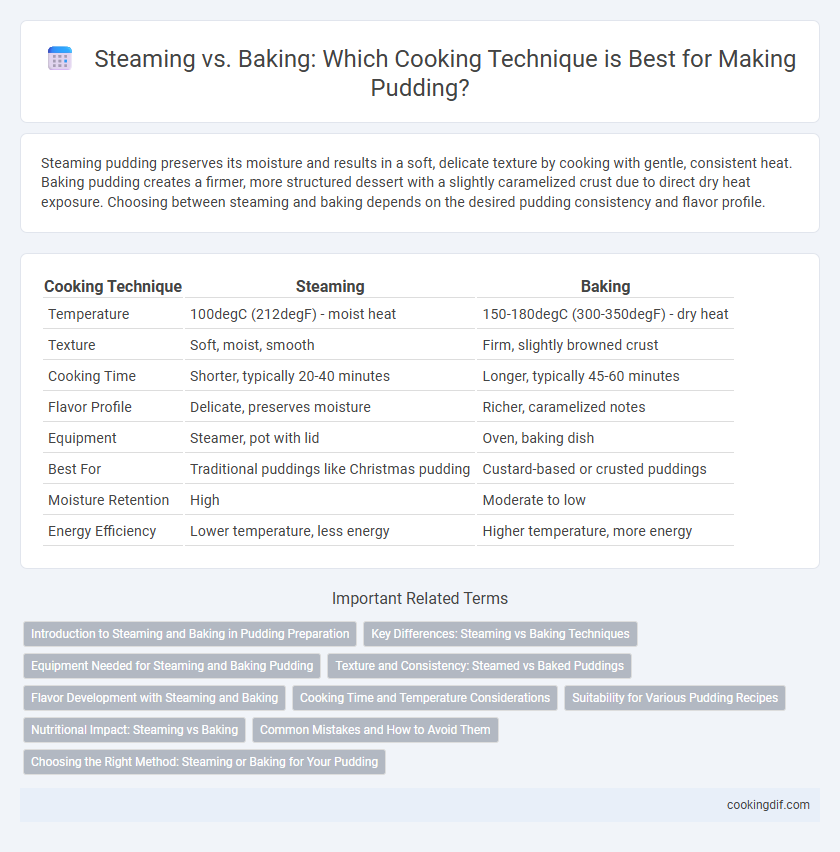Steaming pudding preserves its moisture and results in a soft, delicate texture by cooking with gentle, consistent heat. Baking pudding creates a firmer, more structured dessert with a slightly caramelized crust due to direct dry heat exposure. Choosing between steaming and baking depends on the desired pudding consistency and flavor profile.
Table of Comparison
| Cooking Technique | Steaming | Baking |
|---|---|---|
| Temperature | 100degC (212degF) - moist heat | 150-180degC (300-350degF) - dry heat |
| Texture | Soft, moist, smooth | Firm, slightly browned crust |
| Cooking Time | Shorter, typically 20-40 minutes | Longer, typically 45-60 minutes |
| Flavor Profile | Delicate, preserves moisture | Richer, caramelized notes |
| Equipment | Steamer, pot with lid | Oven, baking dish |
| Best For | Traditional puddings like Christmas pudding | Custard-based or crusted puddings |
| Moisture Retention | High | Moderate to low |
| Energy Efficiency | Lower temperature, less energy | Higher temperature, more energy |
Introduction to Steaming and Baking in Pudding Preparation
Steaming preserves moisture in puddings, creating a soft, delicate texture ideal for traditional British suet or sponge puddings. Baking tends to produce a firmer, slightly crusted exterior, enhancing flavors through caramelization and Maillard reactions. Selecting between steaming and baking depends on the desired pudding consistency and flavor profile.
Key Differences: Steaming vs Baking Techniques
Steaming pudding involves cooking with moist heat, preserving moisture and resulting in a soft, delicate texture, while baking uses dry heat that can create a firmer, more browned exterior. Steamed puddings maintain higher humidity inside the cooking environment, preventing drying and often shortening cooking times compared to baking. Baking puddings allows Maillard reactions to develop flavors and crust, whereas steaming provides a gentle, evenly distributed heat ideal for custard-like consistency.
Equipment Needed for Steaming and Baking Pudding
Steaming pudding requires a steamer or a heatproof dish placed inside a pot with a tightly fitting lid and enough water to create steam, ensuring gentle, even cooking. Baking pudding demands an oven and a suitable baking dish or ramekins, often involving a water bath (bain-marie) to maintain moisture and prevent drying. Essential equipment for steaming includes a stovetop steamer setup, while baking necessitates an oven with temperature control and often a roasting pan for the water bath.
Texture and Consistency: Steamed vs Baked Puddings
Steamed puddings typically result in a moist, dense texture with a smooth and tender consistency due to the gentle cooking environment. Baked puddings often develop a firmer, more structured exterior with a slightly drier crumb, offering a contrast between the crust and the soft interior. The choice of steaming versus baking significantly influences the pudding's moisture retention and overall mouthfeel.
Flavor Development with Steaming and Baking
Steaming preserves the pudding's moisture, resulting in a tender texture and subtle flavor nuances due to gentle heat exposure. Baking promotes Maillard reactions and caramelization, enhancing complex, rich flavors and a slightly firmer crust. Flavor development differs as steaming retains delicate sweetness, while baking introduces deeper, toasted notes.
Cooking Time and Temperature Considerations
Steaming pudding typically requires lower temperatures around 100degC (212degF) and a longer cooking time to ensure gentle, even heat distribution that prevents curdling or drying out. Baking pudding usually involves temperatures ranging from 150degC to 180degC (300degF to 350degF) with shorter cooking times, promoting a firmer texture and browned surface. Choosing steaming or baking affects moisture retention and texture, with steaming preserving softness while baking creates a denser, caramelized crust.
Suitability for Various Pudding Recipes
Steaming preserves moisture and prevents overcooking, making it ideal for delicate puddings like Christmas pudding or sticky rice pudding that require a soft, smooth texture. Baking offers a firmer, caramelized crust suitable for bread puddings or custard-based puddings, enhancing flavor through Maillard reactions. Choosing steaming or baking depends on pudding ingredients and desired texture, with steaming favoring moist, dense results and baking promoting golden, slightly crisp exteriors.
Nutritional Impact: Steaming vs Baking
Steaming pudding preserves more vitamins and minerals by cooking at lower temperatures and reducing nutrient loss compared to baking, which exposes the dish to higher, dry heat that can degrade heat-sensitive nutrients. The moist environment in steaming also helps retain hydration and prevents the pudding from drying out, maintaining its nutritional quality and texture. Baking may enhance flavor through caramelization but can diminish certain antioxidants and B vitamins, making steaming a more nutrient-friendly cooking technique for puddings.
Common Mistakes and How to Avoid Them
Steaming pudding often causes uneven texture if water splashes into the mixture, so always cover the pudding tightly with foil or a lid to prevent this. Baking puddings can result in a dry surface or cracked top due to excessive oven heat; using a water bath maintains gentle, consistent heat for a moist, tender finish. Avoid overcooking by monitoring internal temperature and checking doneness with a toothpick to ensure the pudding sets without becoming rubbery.
Choosing the Right Method: Steaming or Baking for Your Pudding
Steaming preserves moisture and creates a smooth, tender texture ideal for delicate puddings like traditional British Christmas pudding, while baking develops a firmer crust and caramelized flavors suited for richer, denser puddings such as bread or pumpkin pudding. The choice between steaming and baking depends on the pudding's ingredients and desired consistency, with steaming favored for gentle, even cooking and baking preferred for a more robust, golden finish. Consider the equipment available and cooking time, as steaming often requires longer periods but results in a moist pudding, whereas baking offers quicker cooking with a potentially drier exterior.
Steaming vs baking for cooking technique Infographic

 cookingdif.com
cookingdif.com